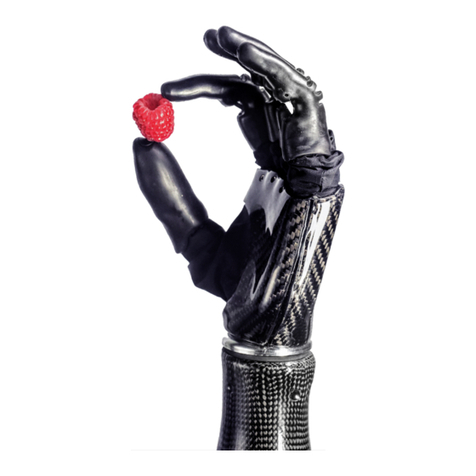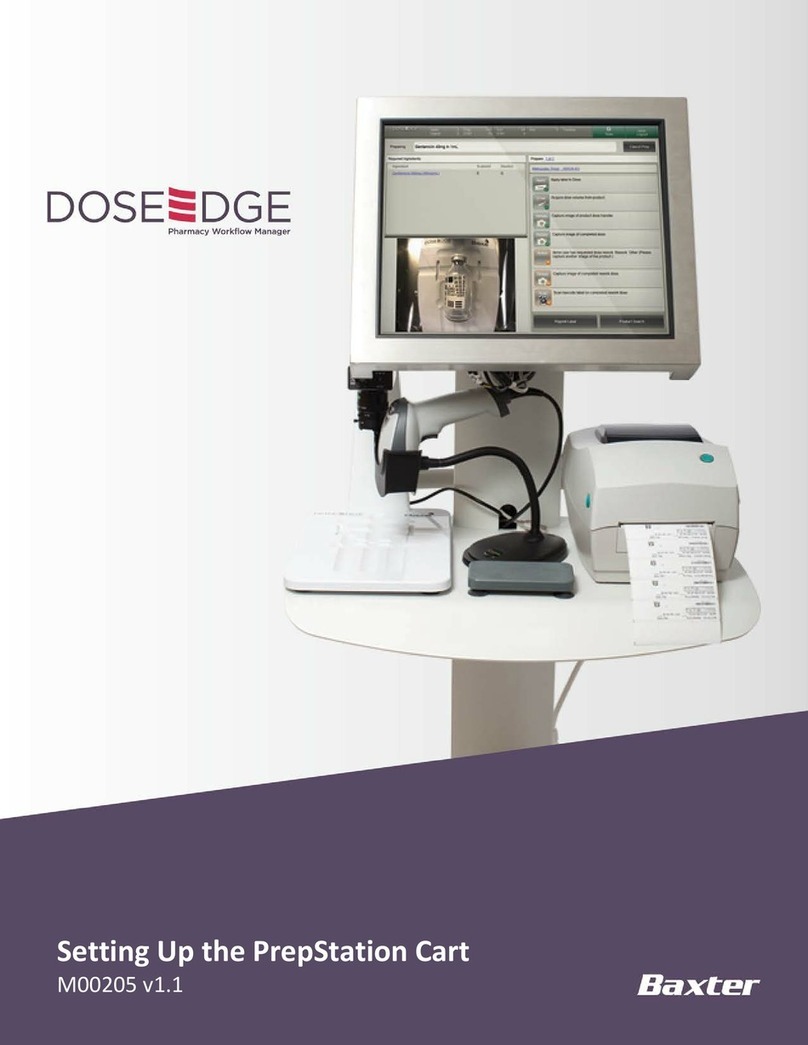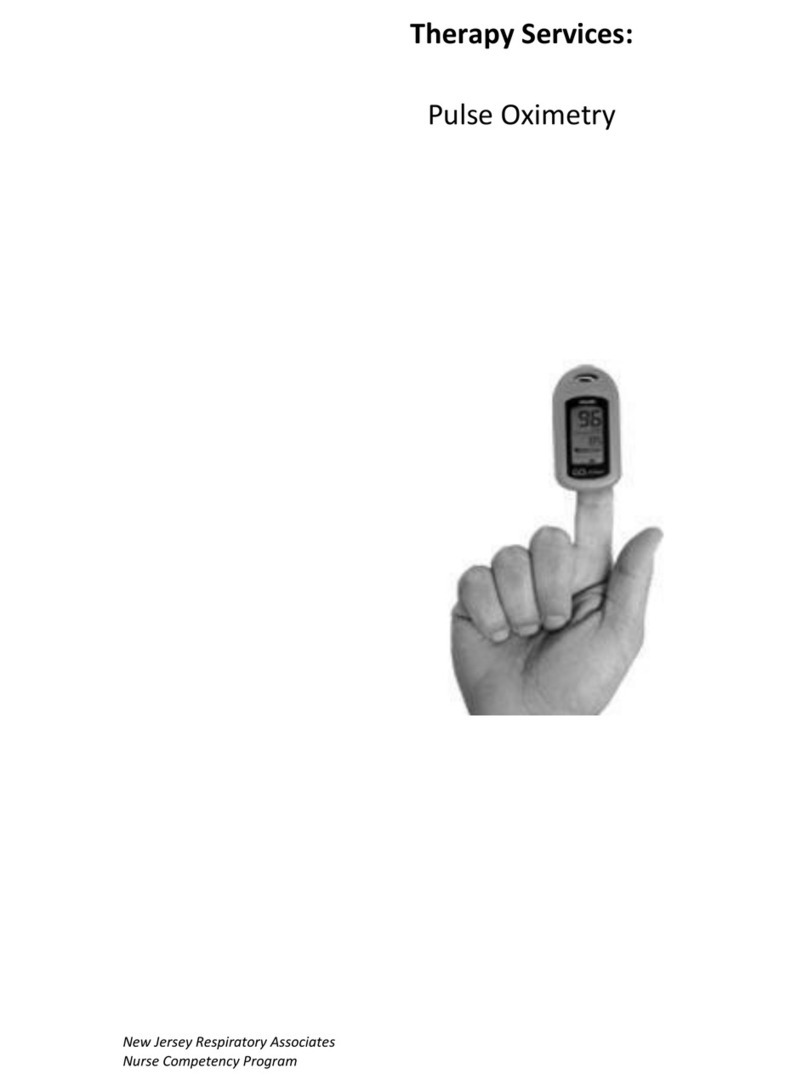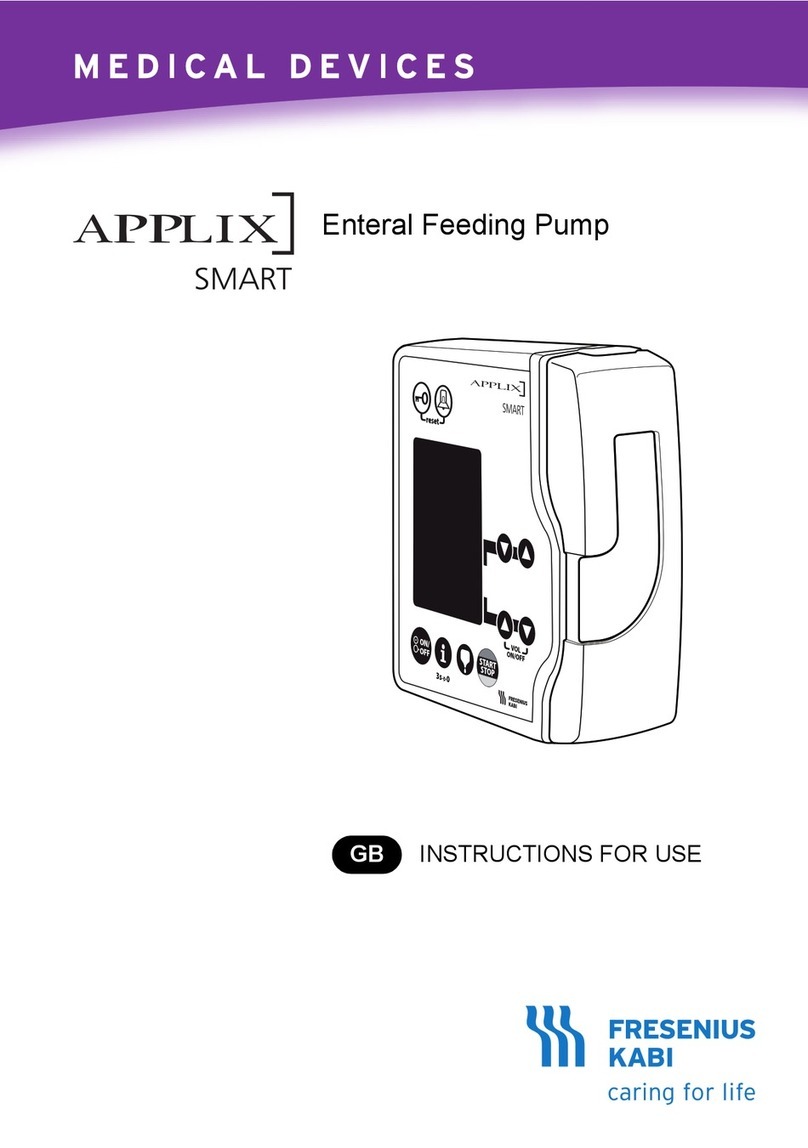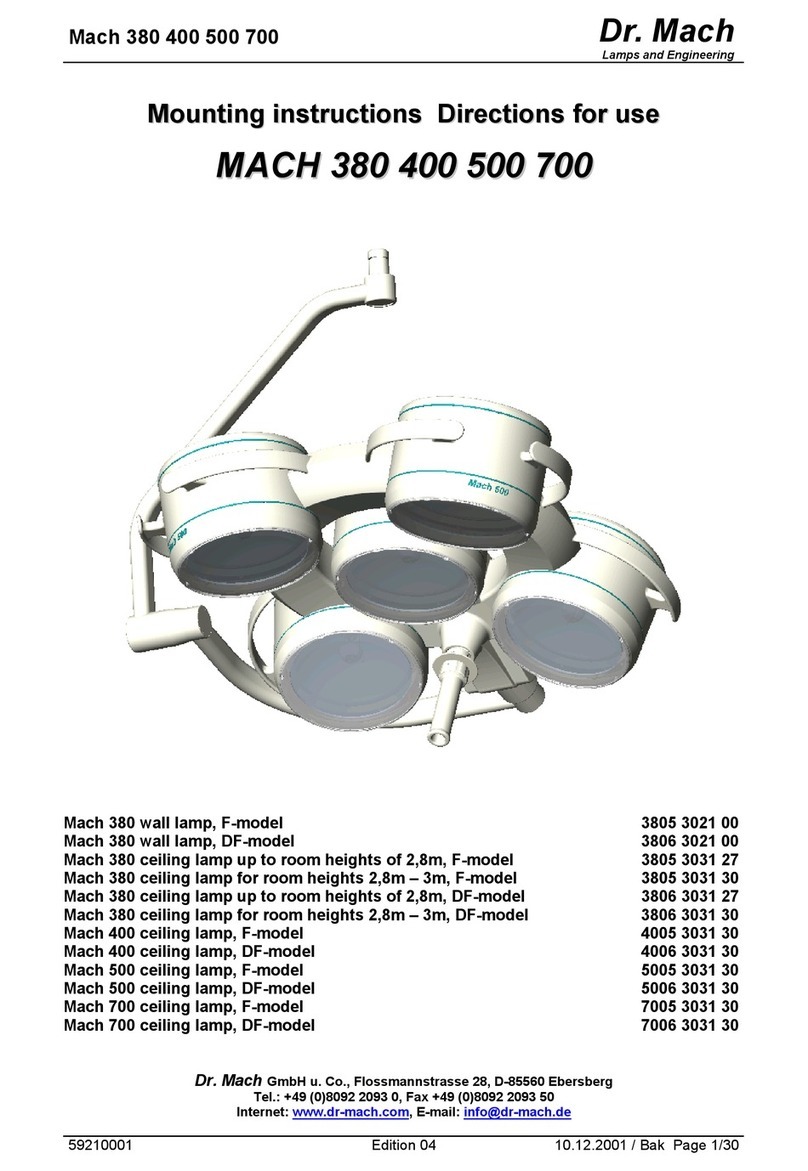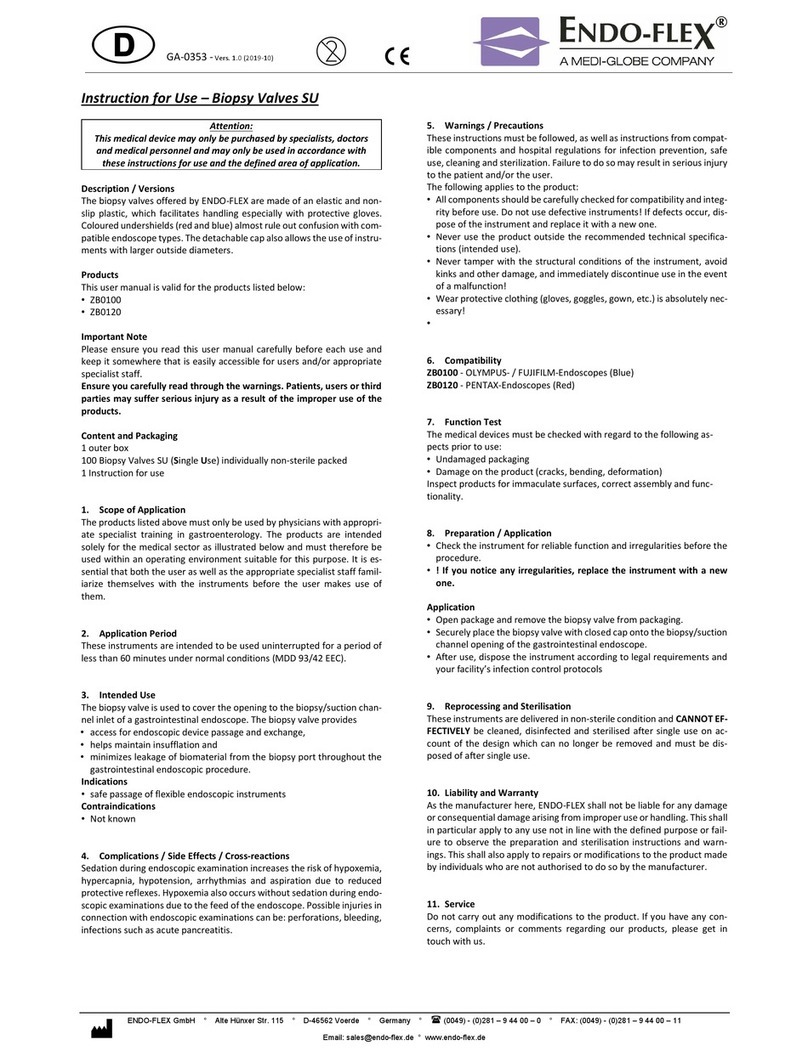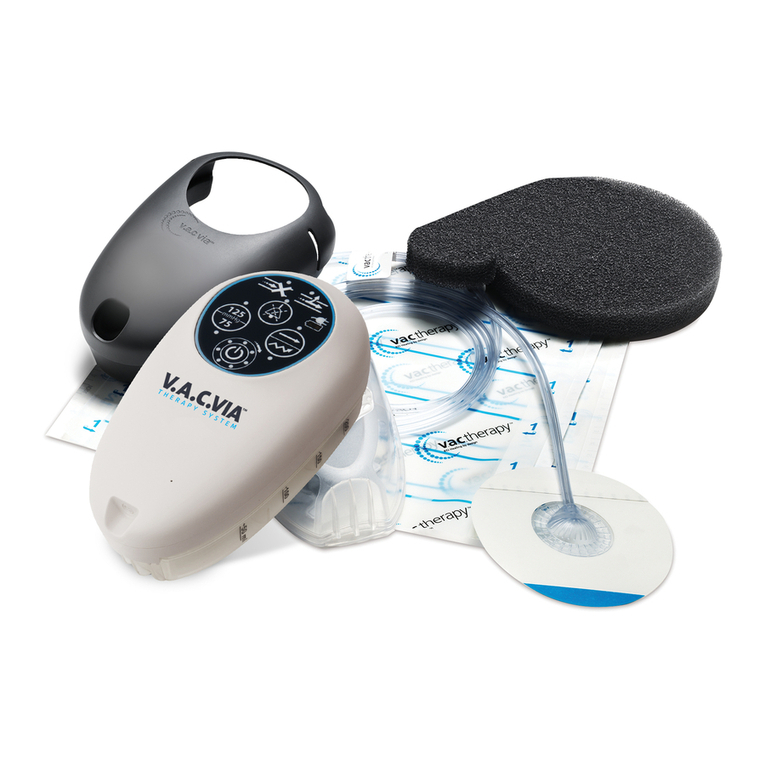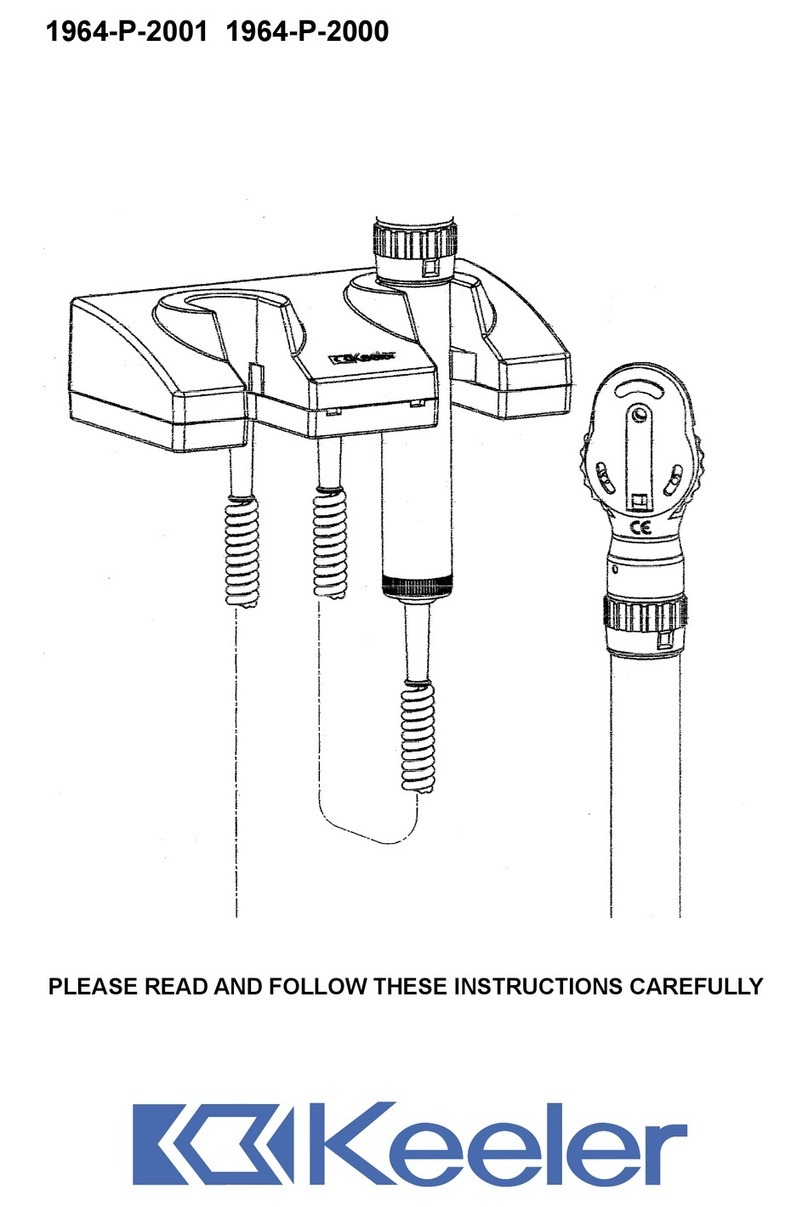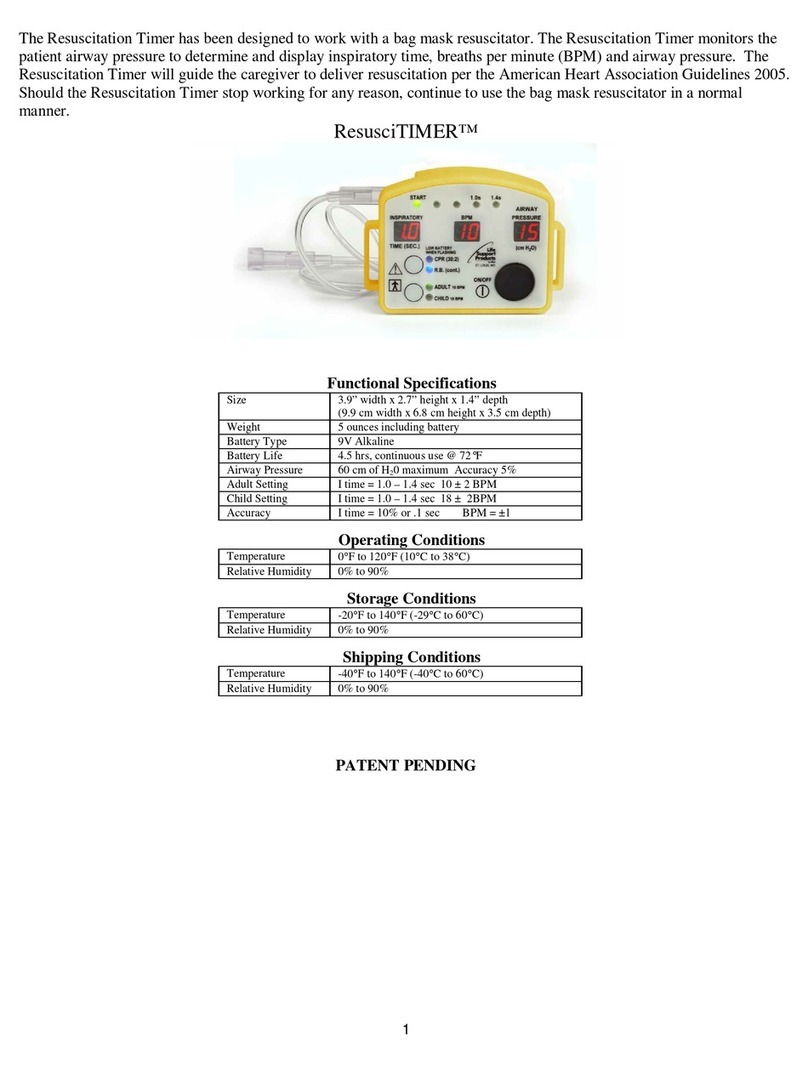PSYONIC THE ABILITY HAND User manual

THE ABILTY HAND™
Product Manual v1.01 last updated October 30, 2019 © 2019
PSYONIC, Inc.
60 Hazelwood Drive
Champaign, IL 61820
888.779.6642

Notice: Federal law restricts this device to sale by or on the order of a physician.
THE ABILTY HAND™
Product Manual

PAGE 4 | ABILITY HAND USER MANUAL ABILITY HAND USER MANUAL | PAGE 5
TABLE OF
CONTENTS
1.1 USER ASSISTANCE AND GETTING HELP
1.2 GENERAL WARNINGS AND PRECAUTIONS
1.3 PURPOSE OF THE ABILITY HAND™
1.4 INDICATIONS FOR USE
1.5 CONTRAINDICATIONS
1.6 LIMITATIONS
1.7 DESCRIPTION OF THE DEVICE
1.8 TECHNICAL SPECIFICATIONS
ELECTRICAL
MECHANICAL
1.0 Ability Hand™ - Overview
2.1 OPERATING CONDITIONS
2.1.1 DUST & WATER
2.1.2 TEMPERATURE
2.1.3 IMPACT & SHOCK
2.2 SETUP
2.2.1 INSPECTION
2.1.2 TEMPERATURE
2.2.2 FABRICATION
2.3 CLEANING
2.4 GRIP PATTERNS
2.5 ACTIVITIES
2.0 operation
3.1 POWERING ON/OFF
3.2 CHARGING THE BATTERY
3.3 BATTERY STATUS INDICATOR
3.4 BATTERY DISPOSAL
3.0 battery
4.1 TECHNICAL SUPPORT
4.2 PSYONIC LIMITED WARRANTY
4.2.1 TERMS AND CONDITIONS
4.2.2 COVERAGE
4.3 RETURNS
4.4 REGULATORY COMPLIANCE
4.0 Additional Information
7
8
10
10
10
10
11
13
15
16
17
17
17
1
14
19
19
20
20
18
22
23
24
24
22

ABILITY HAND USER MANUAL | PAGE 7PAGE 6 | ABILITY HAND USER MANUAL
ABILITY HAND™ OVERVIEW
1.0
The Ability Hand™ is an aordable, durable, and accessible bionic hand. Powered by long-lasting batteries, the
Ability Hand™ provides users with unique and dierentiating features. Available with pressure sensors embedded in
the ngertips, the Ability Hand™ can provide users with tactile touch feedback. All of these features are oered at a
price point that makes advanced activity accessible by almost anyone. We are excited to provide you with an ex-
ceptional bionic hand and to truly redene human.
This document contains information on the usage and care of the Ability Hand™. This product manual should be
fully reviewed before tting the Ability Hand™.
Contact your certied prosthetist if you have any diculty operating your Ability Hand™ or any of its associ-
ated components. You may also contact PSYONIC directly at 1-888-PSYONIC (779-6642).
Additional information and tips for use can be found online at psyonic.co.
USER ASSISTANCE & GETTING HELP
1.1

PAGE 8 | ABILITY HAND USER MANUAL ABILITY HAND USER MANUAL | PAGE 9
GENERAL WARNINGS AND PRECAUTIONS
1.2
The entire contents of this manual must be reviewed before using the Ability Hand™. Failure to do so could result in
suboptimal performance and/or injury to the user or the device itself.
Definitions
1. A Warning is intended to alert you to possible risk of severe injury or accidents.
2. A Precaution is intended to alert you to possible risk of injury or accidents.
3. ANotice is intended to alert you to possible problems associated with the use or misuse causing damage to the
product or its equipment.
Using the Ability Hand™ in a manner that is in violation of the provided Warnings, Precautions, or Notices may result
in damage to the Ability Hand™, injury to yourself or others, and could void any or all warranty coverage for your
Ability Hand™.
warnings
• Do not operate heavy equipment, industrial machines, motor-driven equipment, or machinery while using the
Ability Hand™, as unexpected actions may cause injury.
• Do not handle power tools while using the Ability Hand™, as unexpected actions may cause injury.
• Do not operate a motor vehicle while using the Ability Hand™, as unexpected actions may cause an accident,
serious injury, or death.
• Do not bring the Ability Hand™ into the immediate proximity of any active implanted devices (e.g. pacemakers,
debrillators) without written assurance from a qualied healthcare professional that the systems will not
interfere. Interference between the Ability Hand™ and any implanted devices could cause the implanted device
to malfunction.
• Do not at any time handle or operate a rearm while using the Ability Hand™, as unexpected actions during
rearm operation could result in serious injury or death.
• Do not handle sharp objects or tools (e.g. blades or knives) with the Ability Hand™, as unexpected actions during
handling of sharp objects could result in serious injury or death.
• Do not use the Ability Hand™ while the system battery is charging (i.e. connected to a charger that is plugged into
a standard wall outlet or electrical AC mains), as damage to any of the charging components can result in shock,
serious injury, or death.
• Do not puncture, bend, crush, or strain PSYONIC battery packs or their associated components. Mishandling of
battery components can result in catastrophic failure or re and/or chemical outbreak leading to serious injury, or
death.
GENERAL WARNINGS AND PRECAUTIONS
• Do not submerge the Ability Hand™ in water for any period of time. The Ability Hand™ is only water resistant against mild
splashing up to the wrist connection. Excessive exposure to water could result in irreparable damage to the device and
lead to device malfunction.
• Do not expose the Ability Hand™ to extreme temperatures. Keep the device in environments above 23ºF (-5ºC) and below
122ºF (30ºC) at all times. Exposure to either extreme could cause short or long-term damage to the device and lead to de-
vice malfunction.
• Do not expose the Ability Hand™ to excessive moisture, vibration, dust, or shock. Exposure to excessive environmental con-
ditions could cause short or long-term damage to the device and lead to device malfunction.
• Do not expose the Ability Hand™ to excessive amounts of corrosive substances (e.g. sweat, salt water). Exposure to corro-
sive substances could cause short or long-term damage to the device and lead to device malfunction.
• Do not clean the Ability Hand™ with strong chemicals (e.g. acetone, benzene) or similar solutions. Exposure to strong chem-
icals could cause short or long-term damage to the device and lead to device malfunction.
• Do not use the Ability Hand™ near sources of high energy radio frequency (RF) systems (e.g. large antennae, satellite dish-
es). Exposure to high energy RF systems could cause unexpected actions and lead to device malfunction.
• Use care when operating the Ability Hand™ near an open ame and never allow the device to remain directly over an open
ame for any amount of time. Exposure to an open ame could cause the Ability Hand™ to exceed safe operating tempera-
tures and lead to device malfunction.
• Use care not to allow the Ability Hand™ to become crushed or smashed, as this kind of misuse can cause irreparable dam-
age to the device and lead to device malfunction.
• Use care not to subject the Ability Hand™ to any activity or conditions that would injure a physiologic hand.
• Use care not to operate the Ability Hand™ in areas of excessive electrostatic buildup, as excessive electrostatic discharge
into the Ability Hand™ can lead to device malfunction.
• Do not disassemble or modify the Ability Hand™ or any associated components in any capacity. Always contact your pros-
thetist to arrange alterations to any part of your prosthesis.
notices
• Do not attempt to repair the Ability Hand™ on your own. Please contact your prosthetist or clinician regarding possible
repair. Maintenance, upgrades, and repairs shall be performed by PSYONIC only. Mishandling during maintenance,
upgrade, or repair can cause damage to the Ability Hand™ and lead to device malfunction.
• Do not engage in sporting activities while using the Ability Hand™ without written assurance from a qualied healthcare
professional that it is safe to do so. Use of the Ability Hand™ while engaging in sporting activities can cause irreparable
damage to the device and lead to device malfunction.
precautions

PAGE 10 | ABILITY HAND USER MANUAL ABILITY HAND USER MANUAL | PAGE 11
PURPOSE OF THE ABILITY HAND™
1.3
The Ability Hand™ is an advanced, multi-articulated, prosthetic hand designed to replace missing or lost limbs for
congenital and/or acquired amputees. The Ability Hand™ allows users to regain missing or lost functionality and
complete activities of daily living (ADLs).
Additionally, the Ability Hand™ has added functionality that enhances user experience by detecting the pressure
with which the user is gripping an object. The pressure sensation is transferred to the user via a small vibration mo-
tor embedded in their prosthetic socket.
The Ability Hand™ is designed to operate seamlessly with most reputable prosthetic devices as an easy to inte-
grate interchangeable terminal end device.
INDICATIONS FOR USE
1.4
The Ability Hand™ is to be used exclusively for people with congenital and/or acquired limb dierence.
CONTRAINDICATIONS
1.5
None known.
LIMITATIONS
1.6
Individuals with brachial plexopathy or high-level (i.e. forequarter, shoulder disarticulation) amputations may benet
from evaluation by a qualied medical professional before being t with the Ability Hand™.
THE ABILITY HAND™ PROSTHESIS SYSTEM
CONTAINS THE FOLLOWING COMPONENTS:
1.7
The Ability Hand™ Prosthesis System is an advanced, multi-articu-
lated, prosthetic hand designed to replace missing or lost limbs for
congenital or acquired amputees.
The Ability Hand™ is connected to the user’s prosthesis via an
industry standard quick disconnect interface. Power supply and
control signals are passed through a coaxial plug via connectable
interface cables.
There is no physiological, electrical, or mechanical control system
supplied with the Ability Hand™ Prosthesis System. Users must
consult with their certied prosthetist to determine which control
systems are ideal for their needs and physiologic presentation.
Power is supplied via the PSYONIC Battery Pack, which is a high
capacity, high throughput, 7.4VDC lithium polymer battery.
PSYONIC Battery Pack charging and charge indication is provided
via the PSYONIC Power Switch, which contains a plug for USB-C
charging, a multi-color status indicator, and a power ON/OFF but-
ton.
Finally, the PSYONIC Vibration Unit allows for grip pressure to be fed
back to the user via a small, contactless, vibration motor. The inten-
sity of the vibrational feedback is proportional to the grip pressure
applied at the ngertips of the Ability Hand™ and can be adjusted
via the Ability Software User Interface.
Accessories to the Ability Hand™ include the following:
1. PSYONIC Power Switch Fabrication Aide (1:1 scale disposable
model for use in prosthesis fabrication)
2. PSYONIC Power Switch Fabrication Aide(1:1 scale disposable
model for use in prosthesis fabrication)
3. PSYONIC Vibration Unit Fabrication Aide (1:1 scale disposable
model for use in prosthesis fabrication)
4. PSYONIC Battery Pack Fabrication Aide
5. Ability Software User Interface Phone Application
DESCRIPTION OF THE DEVICE
1The Ability Hand™
2Coaxial Plug with 6-rings
3Psyonic battery pack
4PSYONIC Power Switch
5PSYONIC Vibration Unit
6USB-C 30W Wall Charger
7USB-C Charging Cable

PAGE 12 | ABILITY HAND USER MANUAL ABILITY HAND USER MANUAL | PAGE 13 |
TECHNICAL
SPECIFICATIONS
1.8
ELECTRICAL
OPERATING VOLTAGE: 7.4VDC
MINIMUM BATTERY CAPACITY: 2200mAh
MECHANICAL
Minimum Close Time
• 200ms (Power Grasp)
Weight
• 460g
Dimensions (Large)
• 200mm L x 110mm W x 55mm D
Dimensions (small)
• 189mm L x 110mm W x 55mm D

ABILITY HAND USER MANUAL | PAGE 15PAGE 14 | ABILITY HAND USER MANUAL
OPERATION
2.0
The following section includes information on operational limits and
environmental factors, setup, what to do before using the Ability Hand™,
cleaning, maintenance, and storage.
OPERATING CONDITIONS
2.1
The Ability Hand™ is designed to be durable, but there are physical limits to which the Ability Hand™ can withstand. Pushing any
prosthetic component beyond these limits may cause degraded function, irreparable damage, injury to the user, and can void
warranty coverage. These activities include, for example, extreme sports (e.g., rock climbing, skiing, etc.) or activities causing
excessive strain and/or shock to the prosthetic device (e.g., powerlifting, mountain biking, etc.).
The Ability Hand™ should only be used by the individual for whom it was prescribed. A prosthetic hand is a customizable device
that contains adjustable settings that are tuned by a certied prosthetist. The Ability Hand™ may not perform well for individuals
other than the intended recipient.
Review the General Warnings and Precautions section for more information regarding acceptable conditions for operating the
device.
2.1.1
The Ability Hand™ is designed to be water-resistant. This means that:
1. The Ability Hand™ should never be submerged in water, as doing so will cause irreparable damage to the device and will
void the warranty.
2. The Ability Hand™ can be splashed – up to the wrist connection – with water. The temperature of the water must not exist
outside of the range 32°F to 149°F (0°C to 65°C).
3. Water should never spray, splash, or drip on any part of the wrist connection and/or socket, as this may cause damage to
the batteries or other components.
WATER
2.1.2
The Ability Hand™ is designed to operate under normal temperatures. Subjecting the Ability Hand™ to temperatures outside
of these limits may result in irreparable damage to the device and will void the warranty.
The Ability Hand™ is designed to function within temperatures that:
1. Do not exceed 122°F (50°C)
2. Do not fall below 23°F (-5°C
TEMPERATURE
2.1.3
The Ability Hand™ is designed to withstand bumps and impacts that may occur while naturally swinging your arm. Although it
is designed with a robust durability, it is highly recommended that you avoid repeated, deliberate impact (e.g. slamming, slap-
ping, or severely shaking) the Ability Hand™.
IMPACT & SHOCK

ABILITY HAND USER MANUAL | PAGE 17PAGE 16 | ABILITY HAND USER MANUAL
SETUP
2.2
2.2.1
Be sure to look for visible damage to the Ability Hand™ before use. Signicant physical damage to the Ability Hand™ may
aect use.
If you believe that the Ability Hand™ appears to be signicantly damaged before use, or you experience any problems during
the setup process, please refer to Section “4.1 Technical Support” for further assistance.
INSPECTION
2.2.2
For fabrication of the socket, use the fabrication aides provided. The PSYONIC Power Switch should be positioned such
that the charging port is facing upwards, i.e. the charging port should be proximally oriented compared to It should lay at.
The PSYONIC Vibration Unit should be xated within the socket and not touching the user’s skin, i.e. between the inner and
outer socket layers. The PSYONIC Battery Pack should be xated within the socket shell such that they lay at and do not
come in contact with the user’s skin. An adhesive may be used to xate these components in place.
Fabrication aides are provided with the Ability Prosthesis System and should be used by the prosthetist during fabrication
to ensure adequate space is built into the prosthesis for the system components. Double sided adhesive tape is recom-
mended to hold any of these components in place during fabrication.
The PSYONIC Power Switch should be positioned such that the charging port is facing upwards and lie at against the
hard outer shell of the prosthesis. Use the PSYONIC Power Switch Fabrication Aid to assist in creating an appropriate cut-
out and providing adequate space for the PSYONIC Power Switch.
The PSYONIC Vibration Unit should be positioned between the inner exible and hard outer shells and NOT directly touch-
ing the patient’s skin. Use the PSYONIC Vibration Unit Fabrication Aid to assist in providing adequate space for the PSYON-
IC Vibration Unit.
The PSYONIC Battery Pack should be positioned between the inner exible and hard outer shells and NOT directly touch-
ing the patient’s skin. Use the PSYONIC Battery Pack Fabrication Aid to assist in providing adequate space for the PSYONIC
Battery Pack. Take care not to puncture, bend, or crush the PSYONIC Battery Pack, as this can cause irreparable damage
or injury.
FABRICATION
CLEANING
2.3
Gentle cleaning removes dirt and dust build-up and will help the Ability Hand™ operate
smoothly.
Wipe the silicone ngers clean with a damp microber cloth as needed. If further residue or
dust has collected, point the ngers downward and run a gentle stream of water on the ngers,
then wipe dry with a microber cloth.
Caution: Cleaning agents such as detergent or bleach may harm the Ability Hand™. Use only
mild, non-abrasive soap and water when cleaning the hand.
GRIP PATTERNS
2.4
The Ability Hand™ is designed to provide our users with many grip patterns. Several of the Ability
Hand™ grip patterns are shown below:
Key grip
Key Grip can be used to
handle keys, paper, credit
cards, dishware, or other at
objects.
power grip
Power Grip can be used to
handle heavier workplace
objects like brooms.
pinch grip
Pinch Grip can be used to
handle small objects like
coins or shoelaces.
chuck grip
Chuck Grip can be used to
hold bottles, cans, or other
cylindrical objects.
point grip
Point Grip can be used to
press buttons, type on a
computer keyboard, or tap
on a touchscreen .
ACTIVITIES
2.5
Some examples of acceptable
activities of daily living (ADLs)
include the following:
• Shaking hands
• Typing on a keyboard and us-
ing a computer mouse
• Lifting objects that do not ex-
ceed 50 pounds in weight
• Household activities – cooking,
cleaning, ironing clothing
• Tying shoelaces
• Opening and closing doors,
closets, cabinets
• Drinking beverages
• Wearing the Ability Hand™ in
the rain
• Watering a garden with a hose
or watering bucket

ABILITY HAND USER MANUAL | PAGE 19PAGE 18 | ABILITY HAND USER MANUAL
BATTERY
3.0
The PSYONIC Battery Pack is highly-recommended for powering the Ability
Hand™, as it contains cutting-edge motors that can require extra power
throughput.
Third-party batteries can be used, but may degrade the performance of
the Ability Hand™. Contact PSYONIC before using any third-party battery to
ensure compatibility and safety.
POWERING ON/OFF
3.1
The PSYONIC Power Switch contains a power button that is typically mounted near the middle of the socket. The following
instructions demonstrate how to properly power on and o the Ability Hand™.
1. Ensure the hand and its ngers are clear of any obstructions before powering on. This ensures that each nger gets into its
proper home position.
2. Press and hold the power button for 1 secon to turn on the Ability Hand™. After pressing the power button, each nger will
open on its own, and the power button will illuminate.
3. After each nger has stopped moving, the Ability Hand™ is ready for use. To turn o the Ability Hand™, hold down the
power button until the power button light goes out.
4. If at any point you notice any ngers signicantly out of alignment (i.e. after the power cycle or during a controlled grip),
power the Ability Hand™ o and back on to reset.
If you have reset the Ability Hand™ and you are still experiencing any diculties, please refer to Section 4.1 “Technical Support” for
further assistance.
CHARGING THE BATTERY
3.2
Only use the charging unit provided to you by PSYONIC when charging your PSYONIC Battery Pack..
1. Ensure the prosthesis is resting on a stable surface and is not donned on the user’s arm prior to charging.
2. Plug the charging cord into the USB-C charging port located above the power button.
3. Connect the wall adapter to an appropriate wall socket or similar power source. Charging will begin once the wall adapter
is connected. The power button will illuminate during the charging process.
Approximately one and a half hours of charging time is needed to completely charge the battery after it is fully depleted. When
the power button turns green, the Ability Hand™ is fully charged.

ABILITY HAND USER MANUAL | PAGE 21PAGE 20 | ABILITY HAND USER MANUAL
BATTERY STATUS INDICATOR
3.3
BATTERY DISPOSAL
3.4
The PSYONIC Battery Pack can harm the environment if not disposed of properly. It is highly recommended to con-
tact your local public works or appropriate disposal department to properly dispose of any rechargeable Lithium
ion or Lithium polymer batteries.
100% 75% 25% 0%
BATTERY PACK SAFE HANDLING RECOMMENDATIONS
3.5
The following represents a typical, but non-exhaustive, list of good advice to be provided by the equipment manufac-
turer to the end-user.
• Do not dismantle, open or shred secondary cells or batteries.
• Keep batteries out of the reach of children
• Battery usage by children should be supervised. Especially keep small batteries out of reach of small children.
• Seek medical advice immediately if a cell or a battery has been swallowed.
• Do not expose cells or batteries to heat or re. Avoid storage in direct sunlight.
• Do not short-circuit a cell or a battery. Do not store cells or batteries haphazardly in a box or drawer where they may
short-circuit each other or be short-circuited by other metal objects.
• Do not remove a cell or battery from its original packaging until required for use.
• Do not subject cells or batteries to mechanical shock.
• In the event of a cell leaking, do not allow the liquid to come in contact with the skin or
• eyes. If contact has been made, wash the aected area with copious amounts of water and seek medical advice.
• Do not use any charger other than that specically provided for use with the equipment.
• Observe the plus (+) and minus (−) marks on the cell, battery and equipment and ensure correct use.
• Do not use any cell or battery which is not designed for use with the equipment.
• Do not mix cells of dierent manufacture, capacity, size or type within a device.
• Always purchase the battery recommended by the device manufacturer for the equipment.
• Keep cells and batteries clean and dry.
• Wipe the cell or battery terminals with a clean dry cloth if they become dirty.
• Secondary cells and batteries need to be charged before use. Always use the correct charger and refer to the man-
ufacturer’s instructions or equipment manual for proper charging instructions.
• Do not leave a battery on prolonged charge when not in use.
• After extended periods of storage, it may be necessary to charge and discharge the cells or batteries several times
to obtain maximum performance.
• Retain the original product literature for future reference.
• Use the cell or battery only in the application for which it was intended.
• When possible, remove the battery from the equipment when not in use.
• Dispose of properly.
50%

ABILITY HAND USER MANUAL | PAGE 23PAGE 22 | ABILITY HAND USER MANUAL
ADDITIONAL INFORMATION
4.0
The remainder of this document will provide you with information on
technical support, PSYONIC’s Limited Warranty, return policy, and regulatory
compliance.
TECHNICAL SUPPORT
4.1
If you experience any issues with your Ability Hand™, please contact your prosthetist and describe the issue
in detail. Your prosthetist may be able to immediately assist with any common issues.
You can contact us via email at support@psyonic.co or call us at 1-888-PSYONIC (779-6642) for further
assistance. Our support hours are from 9:00 AM CST to 5:00 PM CST. After Hours Support can be
accommodated with one business day advance notice.
For users:
For Clinician/Prosthetist:
PSYONIC LIMITED WARRANTY
4.2
PSYONIC provides each Ability Hand™ user with the most durable commercially available bionic hand. However, problems may
still arise during the use of the Ability Hand™. If the Ability Hand™ was delivered under a condition that ts the warranty or lost
functionality that falls within the warranty conditions, prompt response and action will be conducted.
TERMS AND CONDITIONS
4.2.1
Every Ability Hand™ includes a two-year limited warranty. Each Ability Hand™ is registered under our limited warranty by your
prosthetist as part of the tting process.
The warranty period begins on the date the Ability Hand is delivered for use outside of tting sessions. .
COVERAGE
4.2.2
PSYONIC’s Limited Warranty covers the following ONLY:
• Errors in the assembly of the Ability Hand™
• Defects in the material used to build each Ability Hand™
• Accidental damage to the Ability Hand™ that does not exceed any operational limits and disobey any safety guidelines or
appropriate usage outlined previously in this manual
PSYONIC’s Limited Warranty does NOT cover the following:
• Regular wear and tear
• Loss of the Ability Hand
• Theft of the Ability Hand
• Cosmetic or minor damage to the Ability Hand™ that does not aect functionality
• Intentional damage to the Ability Hand
• Damage to the Ability Hand™ caused by neglect
• Use of the hand that does not meet the safety guidelines and appropriate use outlined previously in this manual
• Inclement weather, lightning strike, or any acts of nature that expose the Ability Hand™ to dangerous conditions
• Any event not within reasonable control or anticipation by PSYONIC
• Damage caused by animals or insects
• Use of batteries and battery chargers not specically provided by PSYONIC
• Attempts by any individual outside of PSYONIC to repair the Ability Hand™ or carry out maintenance and service to the Ability
Hand
• Connection or installation of the Ability Hand™ to parts that are not compatible with the Ability Hand™
• Alteration or modication to any portion of the Ability Hand

ABILITY HAND USER MANUAL | PAGE 25PAGE 24 | ABILITY HAND USER MANUAL
RETURNS
4.3
If you experience any conditions within the boundary
of the warranty during the two-year warranty period,
please contact your prosthetist for further assistance.
Proof of purchase and details describing any alleged
defects or damages must be documented. Your
prosthetist will need to contact PSYONIC for technical
support to provide further assistance and determine if
replacement or repair is necessary.
To accommodate the return process, a loaned Ability
Hand™ may be shipped to your prosthetist. The loaned
Ability Hand™ will need to be returned to PSYONIC
once a repair has been performed or a replacement
Ability Hand™ has been provided.
REGULATORY COMPLIANCE
4.4
IEC 62133-2:2017 Secondary cells and batteries
containing alkaline or other non-acid electrolytes -
Safety requirements for portable sealed secondary
lithium cells, and for batteries made from them, for use
in portable applications - Part 2: Lithium systems
FCC Part 15, Subpart B, Sections 15.107a & 15.109a;
Subpart C, Section 15.209; for unintentional radiators

PAGE 26 | ABILITY HAND USER MANUAL
Other manuals for THE ABILITY HAND
1
Table of contents
Other PSYONIC Medical Equipment manuals
Popular Medical Equipment manuals by other brands
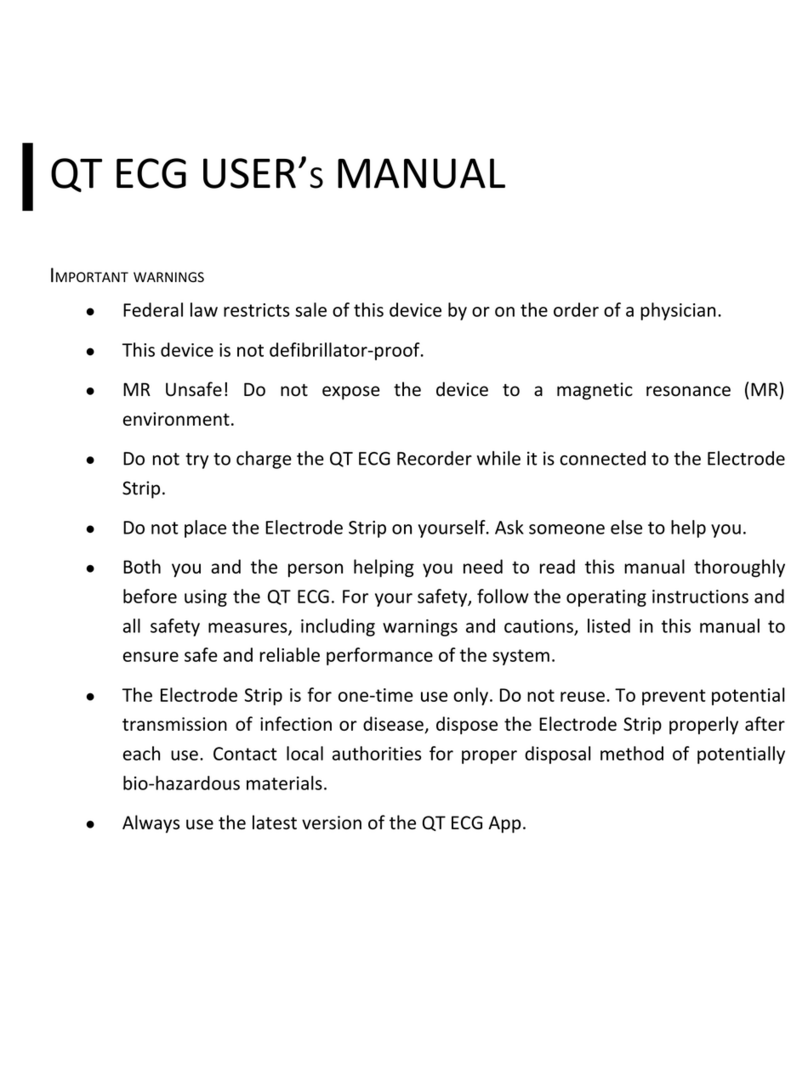
QT Medical
QT Medical QT ECG QTERD100 user manual
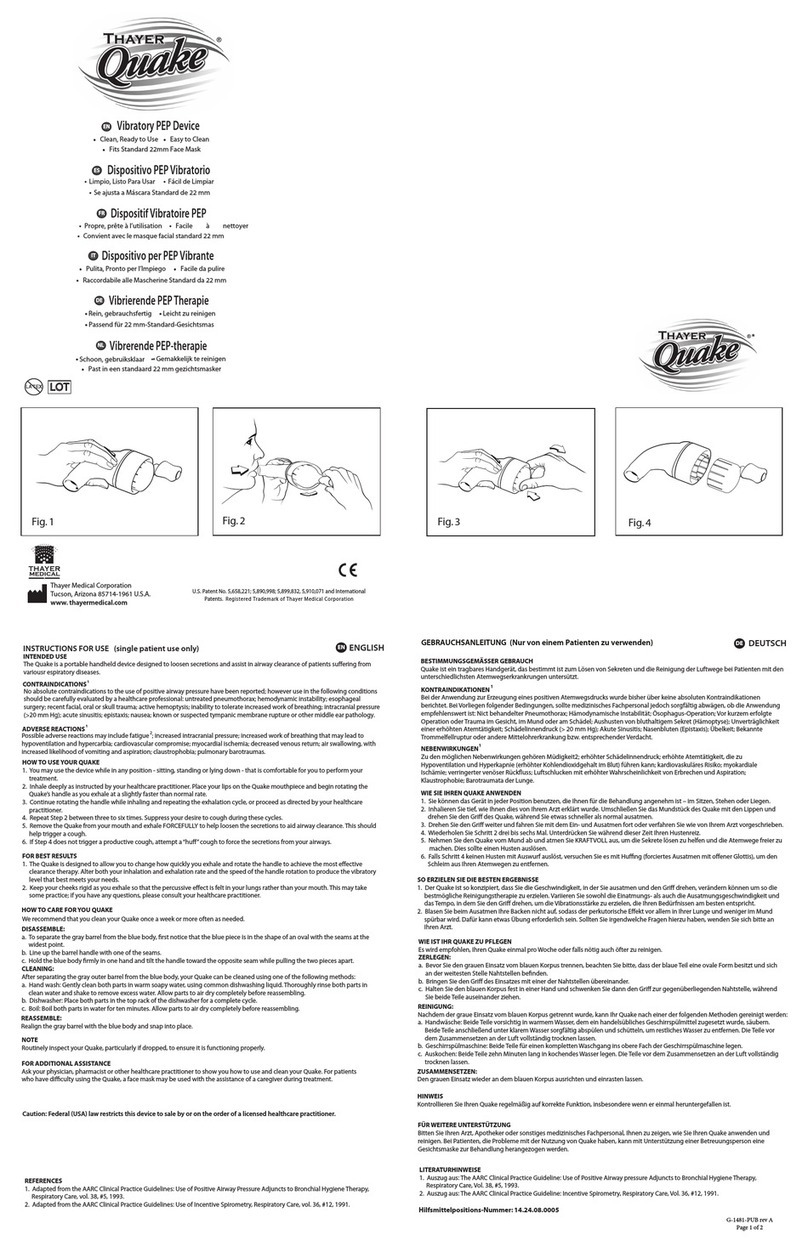
Thayer Medical Corporation
Thayer Medical Corporation Quake Instructions for use

Avita
Avita NS1 instruction manual

bort medical
bort medical 055 500 Instructions for use
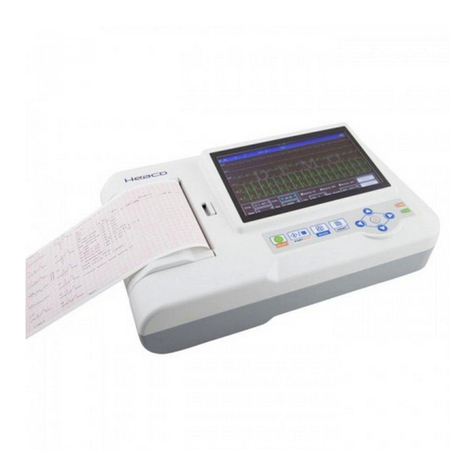
Heaco
Heaco ECG600G user manual
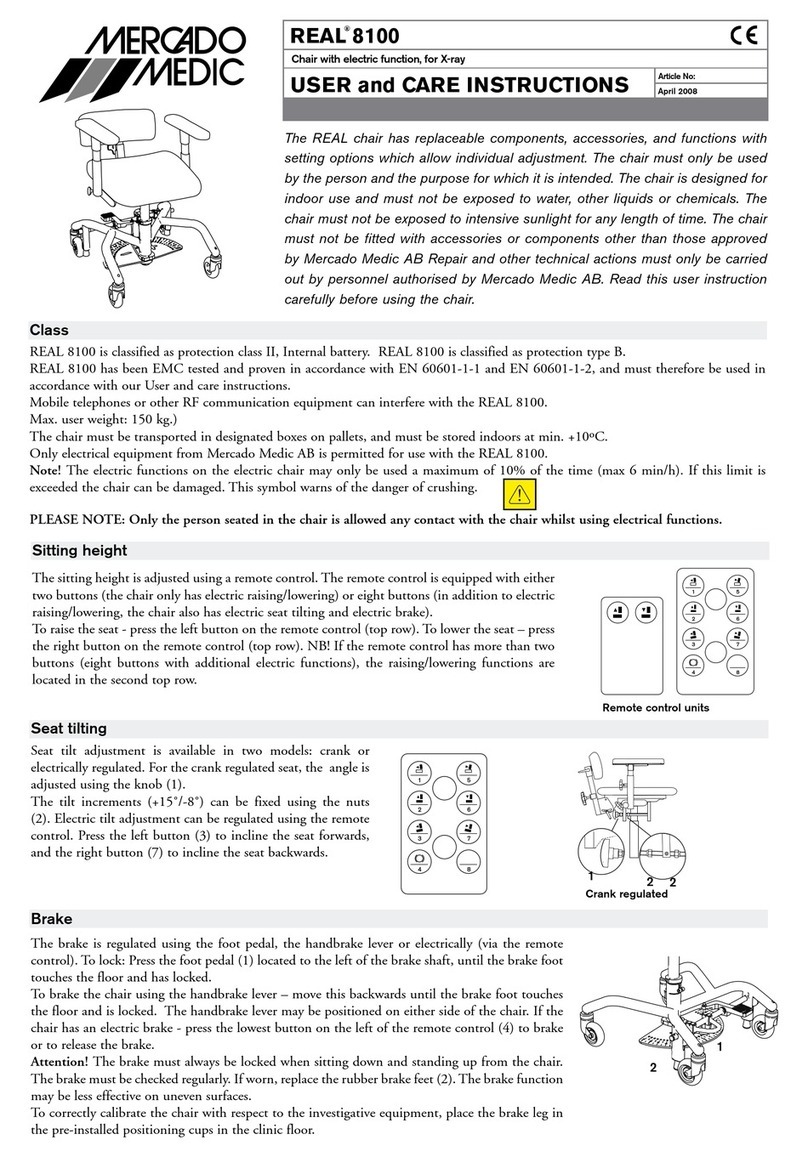
Mercado Medic
Mercado Medic REAL 8100 USER and CARE INSTRUCTIONS
